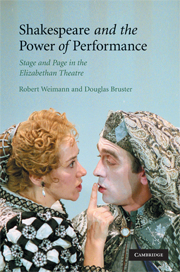Book contents
- Frontmatter
- Contents
- Acknowledgments
- Introduction
- Chapter 1 “Moralize two meanings” in one play: contrariety on the Tudor stage
- Chapter 2 Performance, game, and representation in Richard III
- Chapter 3 Mingling vice and “worthiness” in King John
- Chapter 4 Clowning: agencies between voice and pen
- Chapter 5 Clowning at the frontiers of representation
- Chapter 6 Cross-dressing and performance in disguise
- Chapter 7 Personation and playing: “secretly open” role-playing
- Chapter 8 Character/actor: the deep matrix
- Chapter 9 Character: depth, dialogue, page
- Chapter 10 King Lear: representations on stage and page
- Notes
- Index
- References
Chapter 3 - Mingling vice and “worthiness” in King John
Published online by Cambridge University Press: 22 September 2009
- Frontmatter
- Contents
- Acknowledgments
- Introduction
- Chapter 1 “Moralize two meanings” in one play: contrariety on the Tudor stage
- Chapter 2 Performance, game, and representation in Richard III
- Chapter 3 Mingling vice and “worthiness” in King John
- Chapter 4 Clowning: agencies between voice and pen
- Chapter 5 Clowning at the frontiers of representation
- Chapter 6 Cross-dressing and performance in disguise
- Chapter 7 Personation and playing: “secretly open” role-playing
- Chapter 8 Character/actor: the deep matrix
- Chapter 9 Character: depth, dialogue, page
- Chapter 10 King Lear: representations on stage and page
- Notes
- Index
- References
Summary
When Shakespeare began to write for the London stage, Marlowe's plays were sharply redefining the aims of representation in the Elizabethan theatre. As the prologues to Tamburlaine suggested, the dramatist felt authorized to “lead” the theatre to a new horizon of legitimation, one against which the hero could more nearly be viewed as a self-coherent “picture.” This at least is how the prologue to The Second Part of Tamburlaine the Great projected innovative uses of “this tragic glass” from the earlier play's introduction:
But what became of fair Zenocrate,
And with how many cities' sacrifice
He [Tamburlaine] celebrated her sad funeral,
Himself in presence shall unfold at large.
Such processing of page and stage, the intricate conjuncture of verbal and visual signs, drew on and transformed – even confounded – traditional modes of response. The cultural impact of print helped the protagonist “unfold,” for readers and audience members beholding the scene “at large,” various new shifting, wavering meanings from dramatic fiction.
So it was with good reason that the play's printer, Richard Jones, assumed in his preface to the Octavo and Quarto editions of 1590 that these “tragical discourses” would appeal “To the Gentlemen Readers and others that take pleasure in reading Histories.” Moving from pen to stage and then back to printed page for privileged “reading,” these eminently perusable representations recommended themselves in terms of what “worthiness” the “eloquence of the author” could profitably deliver to a gentle preoccupation with “serious affairs and studies.”
- Type
- Chapter
- Information
- Shakespeare and the Power of PerformanceStage and Page in the Elizabethan Theatre, pp. 57 - 76Publisher: Cambridge University PressPrint publication year: 2008



